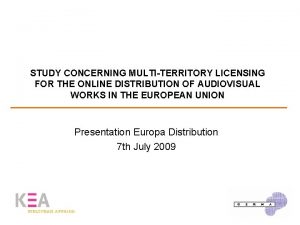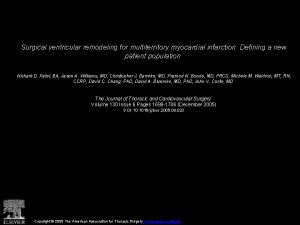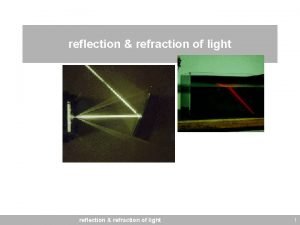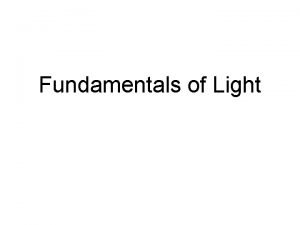MULTITERRITORY LICENSING MULTITERRITORY LICENSING IN THE LIGHT OF

















- Slides: 17

MULTI-TERRITORY LICENSING: MULTI-TERRITORY LICENSING IN THE LIGHT OF THE JULY 16 th EC DECISION (Case COMP/C 2/38. 698 – CISAC) Colman Gota Thompson SGAE Montego Bay , 31 October 2008

MULTI-TERRITORY LICENSING IN THE LIGHT OF THE JULY 16 th EC DECISION (Case COMP/C 2/38. 698 –– CISAC) n I. - The current system of collective management. A justified dominant position. n II. - The system of reciprocal representation agreements. n III- Challenges to the traditional model in the digital environment up to the july 16 th EC decision. a) The challenge of internet licensing. The Santiago and Barcelona Agreements. b) The “Commission Recommendation of 18 May 2005 on collective cross-border management of copyright and related rights for legitimate online music services” n IV. - The CISAC case. The EC July 16 th decision. n V. - Conclusions.

I. - The current system of collective management. A justified dominant position Typical feature of copyright legislations: The rule of noncompetition between collecting societies. n Legal monopolies: Italy (SIAE), Argentina (SADAIC) and Mexico (SACM). n Previous administrative authorisation to operate in most countries: Eg: Germany (GEMA), Belgium (SABAM), Chile (SCD), Greece (AEPI), Spain (SGAE), Switzerland (SUISSA) n Societies that manage the same category of rights but on a exclusive

I. - The current system of collective management. A justified dominant position. Advantages of the dominant position. n Simple and practical system for users: One stop-shop n Legal certainty for users. n Bigger bargaining power for CMO´s against major users. n Less costs for users, less administration fees, and consequently more economical tariffs.

I. - The current system of collective management. A justified dominant position Special Status acknowledged by the European Commission to CMO`s n “In some Member States, rival societies handle the same set of rights. In practice, there a number of instances in which this leads to higher administrative costs both for the societies and for users, and hence to a loss of revenue for rightholders and a disminution in legal certainty” n Mr. Mario Monti´s (Responsible for DG Internal Market) answer on behalf of the European Comission, , to the November 12 th, 1996, written question E-2255/96, posed by Klaus-Heiner Lehne. (O. J. E. C. n° C 105, april 3 rd, 1997)

II. - The traditional system of reciprocal representation agreements. Main Features. n A reciprocal representation agreement is a contract between two collecting societies whereby the societies give each other the right to grant licences for the exploitation of the works of their respective members in the territory of the other collecting society. This extended to the remainining sister societies creates a network whereby all repertoires are reciprocally represented. n This system provides a one-stop shop for a universal repertoire.

II. - The traditional system of reciprocal representation agreements. n European Court of Justice rulings in cases 110/88, 241/88 and 242/88. François Lucazeau and others v. Societé des Auteurs, Compositeurs et Editeurs de Musique (SACEM): has set the principle that: “The territorial delineation of licences along national borders is justified on the basis that duplication of copyright usage monitoring structures in all territories would lack economic rationale. ”

III- Challenges to the traditional model in the digital environment up to the july 16 th EC decision a) The challenge of internet licensing. The Santiago and Barcelona Agreements Main features of the Santiago and Barcelona Agreements (2001 – 2004) n n n Santiago: Performing rights/Barcelona: Reproduction rights. Addendum to the reciprocal representation agreements between CMO´s Content provider concept (Art. 1. 1). Last of the chain. Main features of the Santiago and Barcelona agreements (2001 -2004) Customer allocation clause (Art. II. 3) proximity with the service provider.

III- Challenges to the traditional model in the digital environment up to the july 16 th EC decision European Commission Statement of objections 29/04/2004. Case COMP/C 2/38. 126 (Infringement of art. 81 of Treaty establishing the European Community). Arguments of the statement of objections. n Art. II. 3. The customer allocation clause infringes competition law as it gives absolute exclusivity to CMO´s on their territories. The customer allocation clause has no justification as internet offers the possibility of distant administration thanks to the solutions that technology offers. In the digital environment, any collecting society can control and audit any users, regardless of its economic residence, thanks to new technologies. n Consequences: Elimination of the customer allocation clause in order to

III- Challenges to the traditional model in the digital environment up to the july 16 th EC decision Position of the CMO´s in relation to the statement of objections. The reality of internet proves that efficient administration can only be reached with immediacy an geografical proximity n Market Control n Negotiation n Licensing n Auditing n Legal proceedings

III- Challenges to the traditional model in the digital environment up to the july 16 th EC decision n Plus users don´t seek for the most efficient CMO, they seek for the lowest tariffs, as they usually also seek for the best taxing regime. n A competition on tariffs (“Race to the bottom”) is extremely dangerous.

III- Challenges to the traditional model in the digital environment up to the july 16 th EC decision n b) The “Commission Recommendation of 18 May 2005 on collective cross-border management of copyright and related rights for legitimate online music services”. http: //ec. europa. eu/internal_market/copyright/manage ment/management_en. htm n The Comission changes its criteria: From the users to the clients. n The initiation of the fragmentation of the repertoire.

III- Challenges to the traditional model in the digital environment up to the july 16 th EC decision n CMO´s don´t have to offer the best conditions to the users, but to the rightholders (Eg: publishers). n It sets the principle of licensing on a exclusive or a non-exclusive basis paneuropean licenses through one collecting society. n Increase of Competition between CMO´s, vis-a-vis right-holders, by giving right- holders the possibility to freely choose and move amongst societies: n CMO´s need to negotiate advantageous royalties on their behalf, and improve their services in order to obtain more efficiency at lower costs

IV. - The CISAC case (COMP/C 2/38. 698 – CISAC) Background: The CISAC reciprocal representation model for performing rights (concerning cable, satellite and internet). n RTL lodges a complaint against GEMA which refused to grant RTL a Community wide licence. n Music Choice lodges a complaint against CISAC concerning the CISAC model contract.

IV. - The CISAC case (COMP/C 2/38. 698 – CISAC) Basic points of the complaint to the European Commission concerning the CISAC reciprocal representation model agreement. § § § Article 11 (II). The membership clause. Prohibition of signing non national authors without the consent of the CMO of the respective territory. Article 1 (I and II). Exclusive grant of rights between CMO´s. Article 6. (I and II). Territoriality clause. Each. collecting society licences to its own domestic territories on a mono-territorial basis.

IV. - The CISAC case (COMP/C 2/38. 698 – CISAC) Key points of the july 16 th, European Commission Decision. n The gist of the Commission decision is again that internet offers the possibility of distant administration thanks to the solutions that technology offers. n Territorial delineation is not “per se” and infringement of EU laws. n Violation of articles 81 of the EC Treaty and article 53 of the EEA Agreement. ¿Concerted practices? n What the Decision dictates.

V. - Conclusions n Status Quo. Coexistence of two systems. n Competition amongst CMO´s for the user benefit is not the solution. n Foreseeable future?
 Chapter 22
Chapter 22 Light light light chapter 23
Light light light chapter 23 Into the light chapter 22
Into the light chapter 22 Bouncing off of light
Bouncing off of light Which materials let light through
Which materials let light through Othello put out the light
Othello put out the light Leucoplast double membrane
Leucoplast double membrane đại từ thay thế
đại từ thay thế Thang điểm glasgow
Thang điểm glasgow Quá trình desamine hóa có thể tạo ra
Quá trình desamine hóa có thể tạo ra Công thức tiính động năng
Công thức tiính động năng Thế nào là mạng điện lắp đặt kiểu nổi
Thế nào là mạng điện lắp đặt kiểu nổi Các loại đột biến cấu trúc nhiễm sắc thể
Các loại đột biến cấu trúc nhiễm sắc thể Thế nào là sự mỏi cơ
Thế nào là sự mỏi cơ Bổ thể
Bổ thể Vẽ hình chiếu đứng bằng cạnh của vật thể
Vẽ hình chiếu đứng bằng cạnh của vật thể độ dài liên kết
độ dài liên kết Thiếu nhi thế giới liên hoan
Thiếu nhi thế giới liên hoan

































